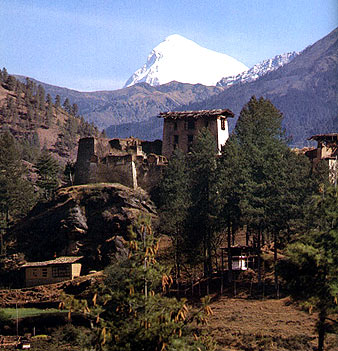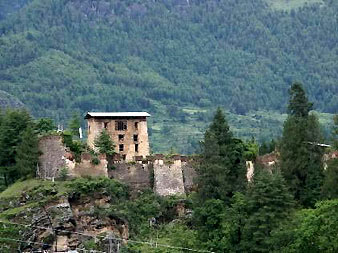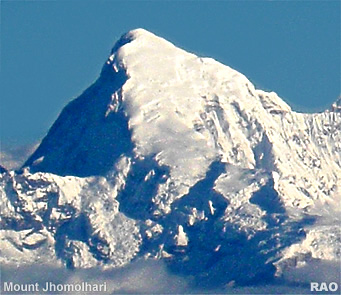 |
Bhutan's
Culture Dzongs |
|
 |
Bhutan's
Culture Dzongs |
|
|
 |
|
Drukgyel
Dzong - Fortress of the Victorious Drukpa
|
 |
| Drukgyel Dzong with Jhomolhari in the background
Drukyel
Dzong is situated 14 km from Paro at the end of the road. Drukgyel
village is lying nearby (3 km in direction of Paro)
This
Dzong was built in location chosen for control of the routes to tibet.
In 1647 the Shabdrung Shabdrung Ngawang Namgyel erected the Drukgyel
Dzong, just north of Taktshang, in commemoration of the victory
over the Tibetans in 1644.
The Shabdrung to celebrated both the unification of Bhutan and the
defeat of their northern rivals, the Tibetans.
Thus
while Bhutan has many cultural associations with Tibetan cultural areas,
it has not been dominated by Tibetan political influence since the 17th
century. |
|
The
name "Drukgyel Dzong" means "Fortress of the Victorious Drukpa".
In 1951 it was destroyed by fire. Now the Dzong is closed to all visitors.
There have been attempts to renovate the buildings.
In
the background there is the Jhomolhari mountain, which is the place
and embodiment of the female mountain goddess Tsheringma, who watches
over the land.
| Tibetan
invasion
The
first Tibetan invasion appears to have taken place shortly after the Shabdrung's
arrival in 1616.
The Tibetan ruler did not want to tolerate the presence of his arch enemy
immediately south of his own territory. It was not enough for the Tibetan
ruler that the Shabdrung had left Tibet; the opponent had to be destroyed.
In
the course of the first Tibetan invasion, the general of the attackers
fell and the Tibetan troops were beaten off. The fame of the Shabdrung
as superior military strategist started to spread. |
 |
 |
| In
Tibet the power of the ruling Tsang collapsed in 1642.
Since then the Gelugpa school, headed by the fifth Dalai Lama,
reigned with the support of the Mongolians. The Gelugpas also thought
that they could not afford a powerful state on their southern border. In 1644, Tibetan
and Mongolian armies attacked Bhutan, but the campaign was not successful.
In 1648/49 several
Tibetan and Mongolian columns again attacked Bhutan at various points. |
|
They
advanced as far as Thimphu, Punakha and Paro, but were ultimately
defeated. Another Tibetan invasion took place in 1657,
after the Shabdrung's death, but failed to achieve anything. It
was the last Tibetan attempt to conquer Bhutan.
| Information on Bhutan |
 |
|





